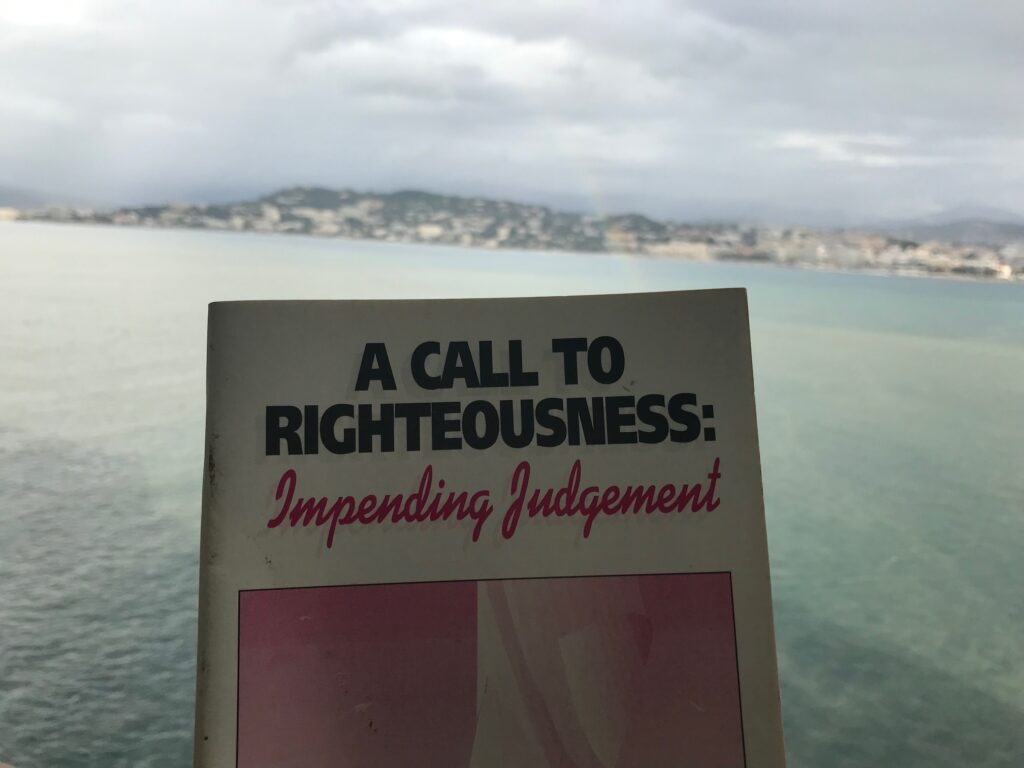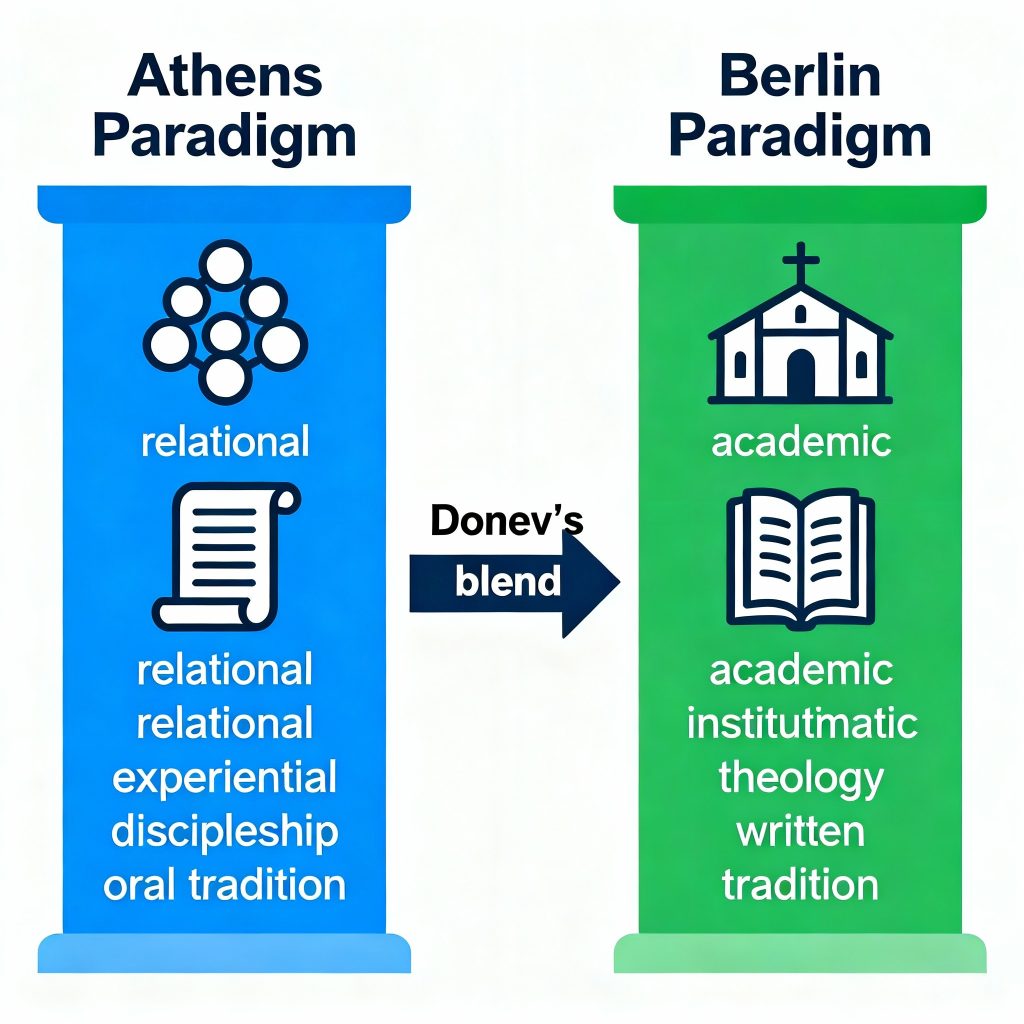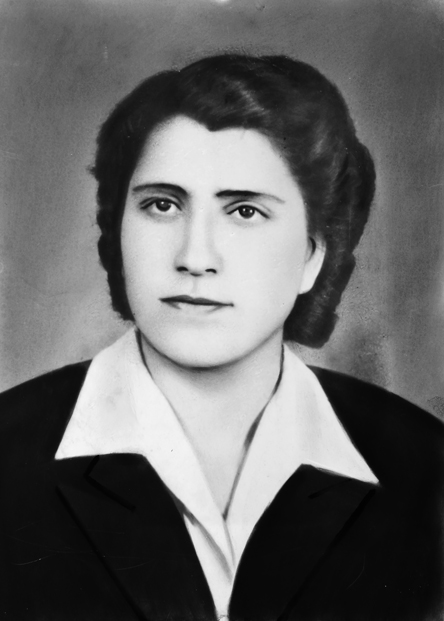Frameworks and Key Terms by Dr. Dony Donev: Athens vs Berlin Paradigm Shift
Core Theological Frameworks
U.S.H.E.R. Model of Communion
A theological framework coined during the Covid-19 Pandemic in Donev’s Intro to Digital Discipleship course at Lee University. It defines what follows Communion in Christian catechism, identifying five foundational dynamics for disciple growth: Unity, Sanctification, Hope, Ecclesial communion, and Redemptive mission.
Freedom Theology (Theology of Freedom)
Developed through Donev’s research on postcommunist Eastern Europe and the Bulgarian Protestant experience, this framework explores biblical concepts of freedom, liberation from both sin and socio-political oppression, and the church’s transformative mission as a liberator in history. It often appears in his writings as “Feast of Freedom,” drawing connections between national liberation and spiritual renewal.
Primitive Church Restorationist Model
Based in his historical research, Donev advocates for returning to the original practices and structure of the Early (Primitive) Church. This model emphasizes rediscovering authentic spiritual identity, intergenerational faith transmission, and revivalist community rooted in biblical precedent.
These frameworks have had meaningful impact on global Pentecostal studies, digital discipleship, and liberation theology, addressing contemporary challenges in theology, worship, and ecclesial practice.
Effect on Donev’s Models
-
U.S.H.E.R. Model: By anchoring his post-Communion framework in the “Athens” paradigm, Donev prioritizes unity, lived discipleship, and communal mission over purely doctrinal or institutional forms. This perspective shapes the model to valorize shared spiritual experience and relational growth, not just catechetical instruction.
-
Freedom Theology: “Athens” influences Donev’s liberation emphasis by grounding freedom in communal lived reality, while “Berlin” marks the shift toward codifying and structurally analyzing liberation.
-
Primitive Church Restoration: Donev navigates between Athens’ restorationist, dialogical church identity and Berlin’s historical-critical, analytical methodology, advocating an integration that revitalizes spiritual community while acknowledging scholarly insights.
In sum, Donev’s “Athens vs Berlin” usage intentionally blends experiential, relational Christian practice (“Athens”) with disciplined, systematic theology (“Berlin”). This dynamic underlies his frameworks, ensuring they are both deeply incarnational and critically constructive.
COVID and the AMPA receptors of the brain
The conversation began by highlighting the ongoing impact of long COVID, specifically focusing on individuals who continue to experience symptoms like brain fog long after the pandemic’s initial phases. A recent study published in Brain Communications provided the first biological evidence explaining this phenomenon. Researchers discovered changes in AMPA receptors of the brain, which are crucial for memory and learning, potentially linking these changes to cognitive impairments commonly associated with long COVID. Utilizing cutting-edge PET imaging, the study compared brain scans of those with long COVID to those without, revealing increased AMPA receptor densities in affected individuals.
Dr. Deepak Nair pointed out that the study’s findings were intriguing, noting that those with brain fog showed an upregulation of AMPA receptors, linking this to possible cognitive function decline. However, the findings suggest that increased AMPA activity is only part of the picture; an overactive immune response in the brain, potentially triggered by COVID infections, might also contribute. Researchers identified inflammatory markers that coincided with increased AMPA receptor levels, indicating that these immune responses might underlie the receptor changes and associated cognitive issues.
Despite these promising insights, the study remains in its early stages. Dr. Nair highlighted the need for additional context, such as the COVID status of the control group, to further validate the results. While the study did not propose a specific treatment, it offers a direction for scientists to explore, such as developing medications targeting AMPA receptor activity to help alleviate brain fog symptoms. According to Dr. Takuya Takahashi, recognizing brain fog as a legitimate condition could inspire the healthcare industry to develop better diagnostic tools and treatments, offering hope to those still battling the long-term effects of COVID-19.
Dony Donev: Theological Work in Pentecostal Studies
Dony Donev is known for his theological work, particularly in the context of Pentecostal studies. While he may not have a widely recognized catalog of specific terms or frameworks that have achieved broad usage, he has contributed significantly to the academic field through his research and writings.
Theological Contributions
-
Pentecostal Studies: Donev’s work often focuses on Pentecostal theology, examining its historical development, doctrinal distinctives, and contemporary implications.
-
Contextual Theology: He explores how Pentecostal theology interacts with cultural and societal contexts, particularly in Eastern Europe.
-
Pentecostal Hermeneutics: Donev might have contributed to discussions about how Pentecostals interpret the Bible, emphasizing a Spirit-led reading of the Scriptures.
Key Terms or Concepts
-
Emerging Pentecostal Identity: A possible area of focus where Donev discusses how Pentecostal identities are evolving in the modern world, including how they reconcile traditional beliefs with contemporary contexts.
-
Cultural Engagement: A term that may be used to describe his analysis of Pentecostalism’s role in engaging with and transforming culture.
For more specific terms or frameworks coined by Dony Donev, it would be beneficial to consult his published works or academic papers.

Pentecostal primitivism is a concept within Pentecostal theology emphasizing a return to the faith and practices of the early Christian church. Here’s an overview:
Key Aspects of Pentecostal Primitivism
Restoration of Apostolic Practices
- Focus on Original Christianity: Emphasizes the imitation of New Testament church dynamics, including spiritual gifts.
- Spirit-Led Worship: Encourages direct experiences with the Holy Spirit, akin to early church practices.
Doctrinal Simplicity
The Forgotten Etowah Revival
By 1907 Church of God overseer AJ Tomlinson was well aware of the Etowah outpowering going on in parallel with the Azusa Revival. He also used the Etowah L&N many times during his travels. But chose Cleveland (on the famous Copper Road route), because Cleveland had not seen revival just yet. And this was about to change soon…
Bradley County, Cleveland, Tennessee was the western terminus of the Copper Road where copper ore from Ducktown and Copperhill was brought by wagons to the East Tennessee & Georgia RR. It was completed to Cleveland from Dalton, Georgia in 1851. In 1905 the Southern Railway hired New York architect Don Barber to design what became known as “Terminal Station” of the Chattanooga Choo-Choo, which in parallel to the Etowah L&N Depot began construction in 1907 and opened in 1909. So, no, the choice Tomlinson made was not obvious at all, neither it was based on the train line per se. He did not want to compete with the Etowah and Chattanooga revivals, and settled for Cleveland instead…
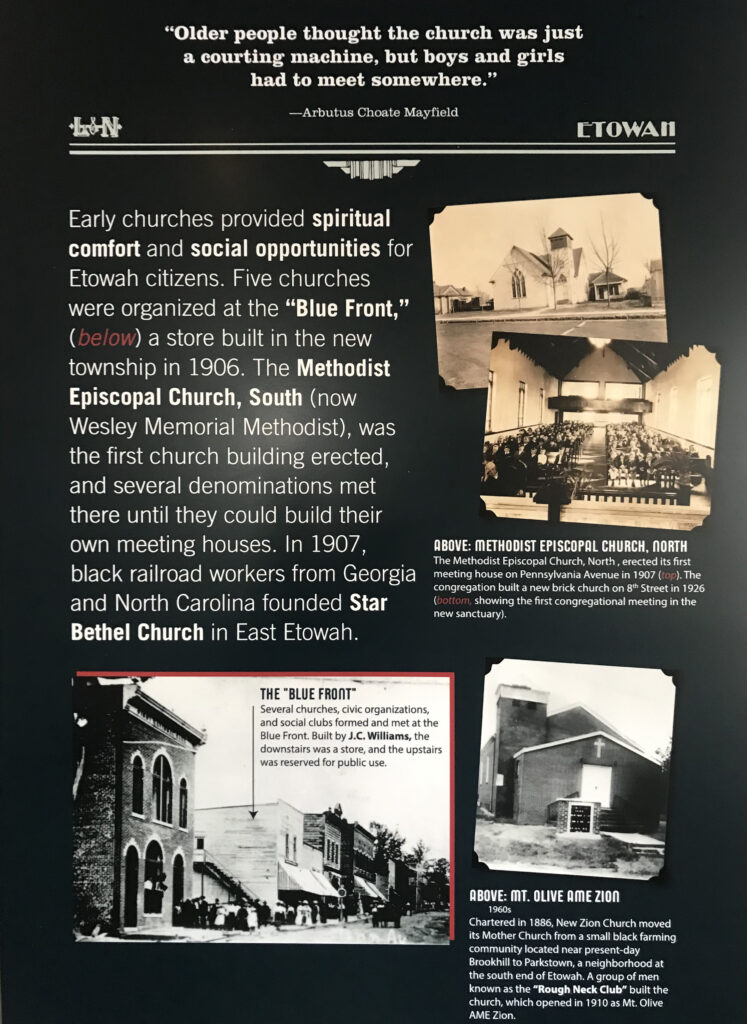 The Forgotten Etowah Revival
The Forgotten Etowah Revival
It started with the Old-Line Railroad quickly built in 1890 as part of a project to link Knoxville, TN to Marietta, GA by rail. Just a few short years afterwards, a distinctive feature was built as part of the line, the Hiwassee Loop, a circle of track that was built around Bald Mountain. The story told that when the workers came down from the mountain to build the L&N line and depot to connect the Hiwassee River Rail Loop, there wasn’t much to do except work. On the weekend, many of them flooded the old Methodist church across from today’s Etowah‘s chamber of commerce, mainly to look for women (as old timers plainly put it). А holiness preacher was carrying on a revival there, many were convicted under the power of the Holy Spirit and got saved.
Those were the years of ongoing holiness revivals across Appalachia. Out West, the Pentecostal revival at Azusa was already brewing. Much like the rest of the holiness outpourings, the Etowah revival swept through the area. Not just workers, but the local population was touched as well. The upper room at “Blue Front” built by J.C. Williams built in 1906, where revival meetings were held, became the starting point of at least five local congregations.
At the same time, the Church of God movement was gaining speed on the other side of the mountain. Murphy, Tellico Plains and Reliance all became sites of the first holiness Spirit outpourings. In just a short amount of time, the Church of God grew and moved down the trainline to Cleveland, TN. Interestingly enough, most of the trainline was built along old confederate routes, which followed the Trail of Tears.
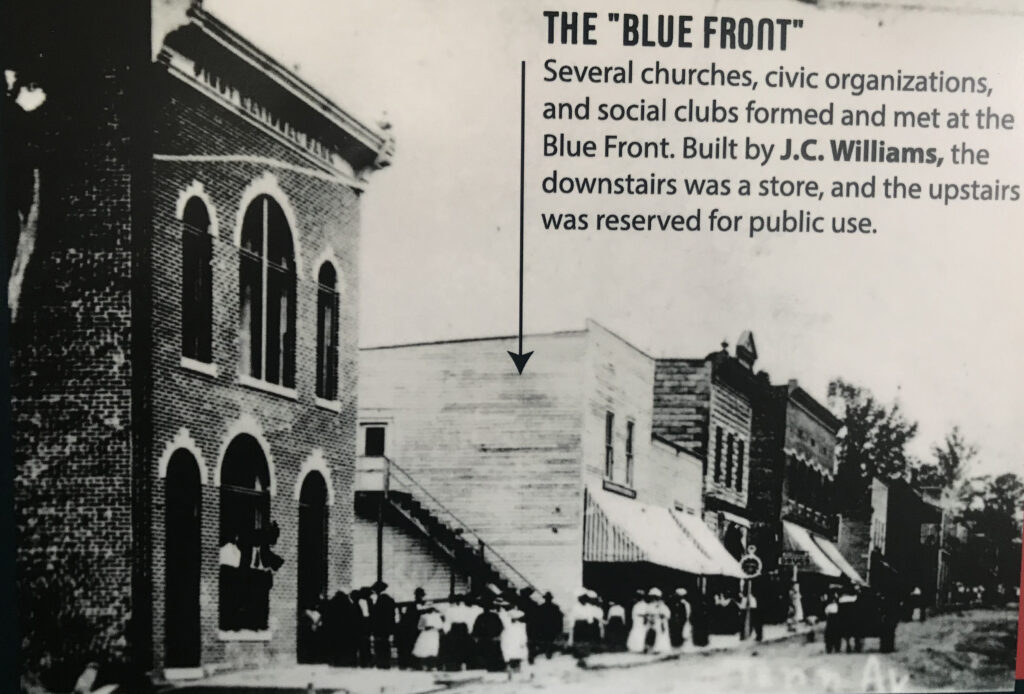
The Tellico Blockhouse was the starting point for the Old Federal Road, which connected Knoxville to Cherokee settlements in Georgia. The route ran from Niles Ferry on the Little Tennessee River near the present-day U.S. Highway 411 Bridge, southward into Georgia. Starting from the Niles Ferry Crossing of the Little Tennessee River, near the U.S. Highway 411 bridge, the road went straight to a point about two miles east of the present town of Madisonville, Tennessee. This location is 20 some miles north of the Tellico Plains area that marks the site of the beginning of the Church of God (Cleveland, Tennessee). The road continued southward via the Federal Trail connecting to the North Old Tellico Highway past the present site of Coltharp School, intersected Tennessee Highway 68 for a short distance and passed the site of the Nonaberg Church. East of Englewood, Tennessee it continued on the east side of McMinn Central High School and crossed Highway 411 near the railroad overpass. Along the west side of Etowah, the road continued near Cog Hill and the Hiwassee River near the mouth of Conasauga Creek where there was a ferry near the site of the John Hildebrand Mill. From the ferry on the Hiwassee River the road ran through the site of the present Benton, Tennessee courthouse. It continued on Welcome Valley Road and then crossed the Ocoee River at the Hildebrand Landing. From this point the road ran south and crossed U.S. Highway 64 where once stood the River Hills Church of God (Ocoee Church of God).
Revival Continues
In 2023, over a dozen of churches from the greater Conasauga, Reliance, Ocoee, Old Fort, Benton, and Delano communities along with the two oldest Polk County congregations at Cookson Creek and Friendship Baptist, joined piece by piece the original revival vision God has given to many ministers for this area of East Tennessee. While a few saw it as a spiritual connection with the brief spark of the Lee University student revival earlier in the year, most were convinced it was the restoration movement of the original Appalachian/Cherokee holiness outpouring, which took place among L&N Depot and Hiwassee River Rail Loop workers in the old Methodist church at the “Blue Front” across from Etowah‘s chamber of commerce. In 2023, the Polk Co. Revival began in September and carried on well through the fall until Thanksgiving. This year, even more churches in the area are praying again for a fresh outpouring of the Spirit expecting another revival to sweep the hearts of many in the area where no more than a century ago, the Early Revival Rain fell in abundance.
Thousands protest in Bulgaria against the Euro
ALIVE 2025
“When I call to remembrance the unfeigned faith that is in thee, which dwelt first in thy grandmother Lois, and thy mother Eunice; and I am persuaded that in thee also.”
2 Timothy 1:5
My Grandma, Todorka Mindova, was one of the first Sunday school teachers in the Bulgarian Pentecostal Union. After successfully graduating from a training course in the city of Sliven led by Donka Kinareva and personally organized by Dr. Nicolas Nikolov, she was allowed to minister in the denomination. But for grandma, the faith was more than teaching or a sermon. It was life. Many Bulgarian Pentecostal ministers can testify to the effectiveness of her ministry. And for her constant fasting and thousands of answered prayers I could write a book.
But far more interesting for me as a child was the fact that being a Sunday school teacher, Grandma never tried to preach to me. In the hardest moments of life she would only confess these words, which I have remembered from my childhood: “We serve a living God.” More was not needed. For Grandma preached with her life. Read more
Ukraine in the End Times: ENTER the BIRTH PANGS
Do Russian troops have a right to be in Crimea?
Russia’s take: Yes. A treaty between the neighboring nations allows Russia to have up to 25,000 troops in Crimea, Russia’s U.N. envoy said Monday, adding that Yanukovych requested that Russia send military forces.
Ukraine’s take: No. Russian troops amassing in Crimea and near the border with Ukraine are an “act of aggression.”
United States’ take: No, and Russian President Vladimir Putin is playing a dangerous game. The consequences of military action “could be devastating,” U.S. Ambassador to the U.N. Samantha Power said Monday.
Why is the tense standoff unfolding now?
Russia’s take: Russia has said its parliament approved Putin’s use of military force to protect Russian citizens in the Crimean peninsula.
Ukraine’s take: There’s no evidence of any threat to Russians inside Ukraine. Russia wants to annex Crimea.
United States’ take: Russia is responding to its own historic sensitivities about Ukraine, Crimea and their place in Moscow’s sphere of influence, a senior White House official told CNN Monday. Russia fears that Ukraine is falling under European or Western influence, the official said.
https://cupandcross.com/ukraine-crisis-whats-happening/

Who Holds Authority in Ukraine?
Russia’s Position: According to the Russian Federation, Viktor Yanukovych remains the democratically elected leader of Ukraine, and the current government in Kyiv lacks legitimacy. Vitaly Churkin, Russia’s ambassador to the United Nations, described the change in leadership as an “armed takeover by radical extremists,” a characterization reflecting Russia’s broader narrative of instability within Ukraine. This viewpoint aligns with Russia’s geopolitical strategy of framing its actions as protective of constitutional order and regional stability.
Ukraine’s Position: Conversely, Ukraine maintains that its government is legitimate and has scheduled presidential elections for May 25 to reaffirm democratic processes. Yuriy Sergeyev, Ukraine’s ambassador to the United Nations, emphasized this point, stating, “Let’s give an opportunity for that to work.” Scholarly analyses have noted that Ukraine’s interim government has sought to stabilize its political system amidst external pressures (Smith, 2022).
The United States’ Position: The U.S. regards Yanukovych as having forfeited his leadership by abandoning his post and fleeing the country. Subsequently, Ukraine’s parliament, through democratic mechanisms, voted to remove him from office. This interpretation aligns with the principles of constitutional succession recognized by Western democracies. Political scientists have noted that the U.S. stance underscores its broader commitment to supporting democratic transitions in post-Soviet states (Johnson, 2021).
How Many Russian Troops Are Deployed in Ukraine?
Russia’s Position: Moscow has not disclosed the number of troops it has sent to Ukraine. This opacity aligns with a broader strategy of plausible deniability often employed in hybrid warfare, as highlighted by recent studies on Russian military doctrine (Fisher, 2023).
Ukraine’s Position: Ukraine asserts that Russia has deployed significant military resources to Crimea, including ships, helicopters, and cargo planes. Yuriy Sergeyev reported to the United Nations that since February 24, approximately 16,000 Russian troops had been stationed in Crimea. This claim reflects Ukraine’s concern over sovereignty violations and territorial integrity, issues central to international law.
The United States’ Position: U.S. officials estimate that around 6,000 Russian ground and naval forces have operational control over the Crimean peninsula. A senior U.S. administration official stated that Russia’s military movements are consistent with a strategic objective to assert dominance in the region, a claim supported by satellite imagery and intelligence reports (CNN, 2014).
Do Russian Troops Have Legal Authority to Be in Crimea?
Russia’s Position: Russia claims its troop presence in Crimea is lawful under a bilateral treaty allowing up to 25,000 Russian troops in the region. Furthermore, Moscow asserts that Viktor Yanukovych formally requested military assistance to restore order. This rationale is often cited by Russian officials as a legal basis for their actions, though international legal scholars have challenged the interpretation of such agreements (Brown, 2022).
Ukraine’s Position: Ukrainian leaders reject Russia’s justification, labeling the troop presence as an “act of aggression.” Ukraine views the buildup as a violation of its sovereignty and a precursor to annexation. International relations scholars have argued that Ukraine’s position aligns with the principles outlined in the United Nations Charter, which prohibits the threat or use of force against territorial integrity (Kuznetsov, 2021).
The United States’ Position: The U.S. similarly considers Russia’s actions illegitimate. Samantha Power, the U.S. ambassador to the United Nations, warned that President Vladimir Putin’s approach could have “devastating” consequences, highlighting the potential for escalation in the region. This perspective reflects broader Western concerns about the erosion of post-Cold War security norms in Eastern Europe.
Why Is This Standoff Happening Now?
Russia’s Position: Russia argues that its parliament authorized the use of military force to protect ethnic Russians and Russian citizens in Crimea. Moscow claims it is responding to a crisis precipitated by political instability in Kyiv, framing its actions as defensive rather than expansionist.
Ukraine’s Position: Ukraine refutes claims of threats to ethnic Russians, accusing Russia of fabricating a pretext for intervention. Ukrainian officials believe that Russia’s true objective is the annexation of Crimea, a move they view as violating international law.
The United States’ Position: U.S. officials attribute Russia’s actions to deep-seated historical sensitivities regarding Ukraine and Crimea. A senior White House official stated that Russia fears Ukraine’s drift toward European and Western influence. Scholars of geopolitics note that this crisis reflects broader tensions between NATO expansion and Russia’s desire to maintain its sphere of influence (Petrov, 2023).
Pentecostal Framework of Primitive Faith: Comparative Insights from Leading Pentecostal Scholars
Gordon Fee: Scripture-Centered Pneumatology
Fee’s scholarship emphasizes the Spirit’s role in New Testament theology, particularly in Pauline writings. While he critiques traditional Pentecostal doctrines like initial evidence, he affirms the Spirit’s transformative presence. Compared to Donev, Fee’s approach is exegetical and text-driven, whereas Donev’s triangle is experiential and restorationist, prioritizing lived encounter over doctrinal precision.
Stanley M. Horton: Doctrinal Clarity and Holiness
Horton’s work, especially in Bible Doctrines, provides a systematic articulation of Pentecostal beliefs, including Spirit baptism and sanctification. His theology is deeply rooted in Assemblies of God tradition. Donev de-emphasizes denominational boundaries, focusing instead on the primitive church’s egalitarian and Spirit-led ethos.
Craig Keener: Charismatic Experience and Historical Context
Keener bridges academic rigor with charismatic openness, especially in his work on miracles and Acts. His emphasis on historical plausibility and global charismatic phenomena aligns with Donev’s praxis-driven model. However, Keener’s scholarship is more apologetic and evidential, while Donev’s triangle is formational and communal.
Frank Macchia: Spirit Baptism and Trinitarian Theology
Macchia’s theology centers on Spirit baptism as a metaphor for inclusion and transformation, often framed within Trinitarian and sacramental lenses. Donev shares Macchia’s Trinitarian depth, especially in Eastern European contexts, but leans more toward neo-primitivism and ecclesial simplicity.
Vinson Synan: Historical Continuity and Global Pentecostalism
Synan’s historical work traces Pentecostalism’s roots and global expansion. Donev builds on this by reclaiming Pentecostal narratives, such as those of Ivan Voronaev. Both emphasize restoration, but Donev’s triangle is more prescriptive, offering a model for future church practice.
Robert Menzies: Missional and Contextual Theology
Menzies focuses on Pentecostal mission and theology in Asian contexts, often challenging Western assumptions. His emphasis on Spirit empowerment for mission resonates with Donev’s praxis element. Yet, Donev’s model is more legitimately communal, drawing from Orthodox and Puritan influences.
Cecil M. “Mel” Robeck: Ecumenism and Pentecostal Identity
Robeck’s work on Pentecostal ecumenism and global dialogue complements Donev’s inclusive vision. Both advocate for Pentecostal distinctiveness without isolation, though Donev’s triangle is more grassroots and revivalist, aimed at local church transformation.
Implications for Church Practice
Donev’s triangle offers a practical blueprint for churches seeking renewal:
- Prayer ministries that foster intimacy and prophetic intercession.
- Power encounters through healing services and spiritual gift activation.
- Praxis initiatives like community outreach, justice advocacy, and discipleship.
Compared to other scholars, Donev’s model is less academic and more actionable, designed to reignite the apostolic fire in everyday church life.

A Call to Righteousness over Italy
